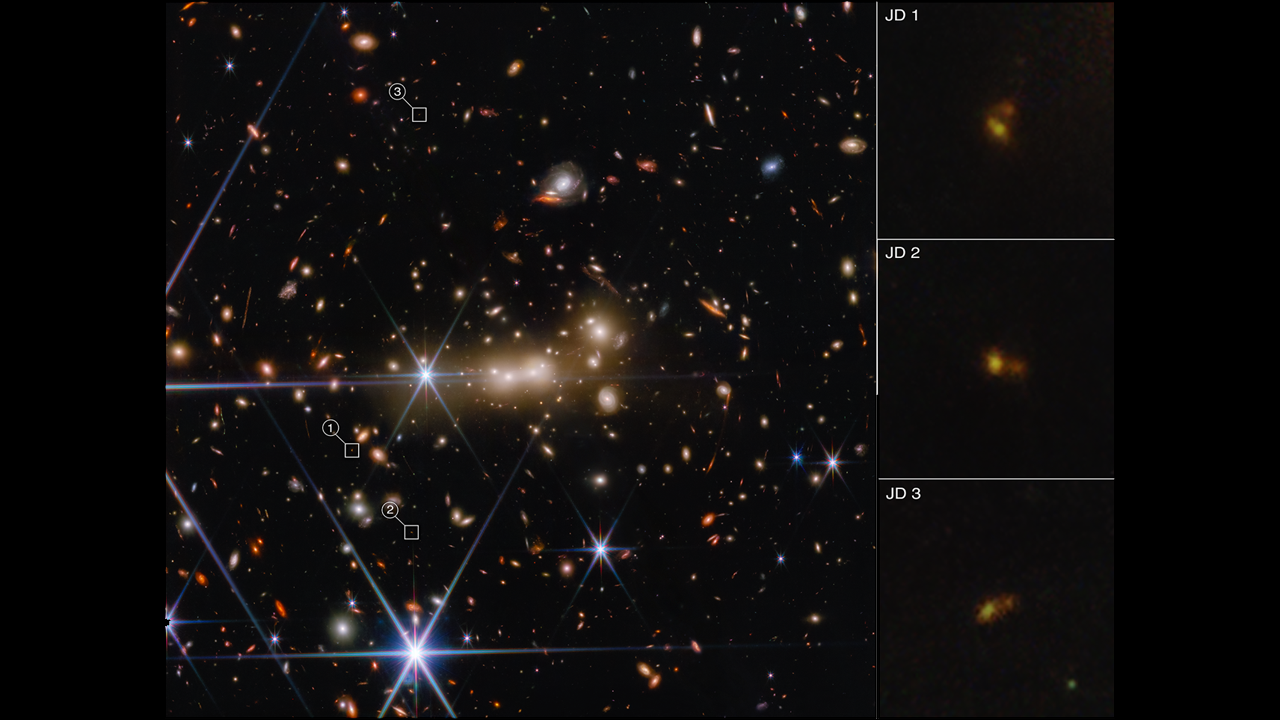New James Webb Space Telescope photos show a massive galaxy cluster bending light
Is it two galaxies, or two star clusters? Astronomers aren't yet sure what the James Webb Space Telescope spotted in an image of the early universe.

In a dance of dark matter, NASA's deep-space observatory caught light being bent in the distant universe.
The massive James Webb Space Telescope mirror used a galaxy cluster's gravity to take a look at a known galaxy far behind, but there's a twist: the new research published Wednesday (Oct. 26) suggests Webb may be viewing two galaxies and not one. (The region has been imaged before by the Hubble Space Telescope, but this new view is sharper than ever.)
"We're actively discussing whether these are two galaxies, or two clumps of stars within a galaxy," Space Telescope Science Institute astronomer Dan Coe, an instrument scientist for Webb's near-infrared camera, said in a NASA statement. "We don't know, but these are the questions that Webb is designed to help us answer."
Related: Why the James Webb Space Telescope's amazing 'Pillars of Creation' photo has astronomers buzzing
Hubble saw the objects, found 10 years ago and called MACS0647-JD, as a "pale, red dot" formed just 400 million years after the Big Bang that kickstarted the universe, according to Coe. While Webb revealed that one object was actually two, the nature of what the new telescope is seeing remains a mystery.
Webb's team is committed to releasing science in progress and as such, this finding is not yet peer-reviewed and is still in early discussion. If Webb spotted two galaxies, there's an even more intriguing possibility: a galactic merger might be in progress in the early universe.
"If this is the most distant merger, I will be really ecstatic," said Tiger Yu-Yang Hsiao, a Ph.D. graduate student at john Hopkins University, in the same statement. But whether Webb is viewing two star clusters or two galaxies, there are clear differences between them: one object set is slightly bluer with lots of stars, and the other is slightly redder with lots of dust.
Get the Space.com Newsletter
Breaking space news, the latest updates on rocket launches, skywatching events and more!
Webb's use of gravitational lensing is not new to astronomy, but exploiting the ability of massive objects to bend light will bring new insights with the telescope's sensitive instruments. Webb is optimized to look at the early universe, which is receding rapidly from us in infrared wavelengths.
Webb's expected 20 years of space observations will greatly expand our catalog of early galaxies from "only tens" of objects to many more, said Rebecca Larson, a National Science Foundation fellow and Ph.D. graduate student at the University of Texas at Austin.
"Studying them can help us understand how they evolved into the ones like the galaxy we live in today, and also, how the universe evolved throughout time," Larson said in the same statement. She added she is looking forward to when Webb can create "deep fields" of a single spot in the sky, as Hubble did numerous times, as this will uncover even more objects in the early universe.
Follow Elizabeth Howell on Twitter @howellspace. Follow us on Twitter @Spacedotcom or Facebook.
Join our Space Forums to keep talking space on the latest missions, night sky and more! And if you have a news tip, correction or comment, let us know at: community@space.com.

Elizabeth Howell (she/her), Ph.D., was a staff writer in the spaceflight channel between 2022 and 2024 specializing in Canadian space news. She was contributing writer for Space.com for 10 years from 2012 to 2024. Elizabeth's reporting includes multiple exclusives with the White House, leading world coverage about a lost-and-found space tomato on the International Space Station, witnessing five human spaceflight launches on two continents, flying parabolic, working inside a spacesuit, and participating in a simulated Mars mission. Her latest book, "Why Am I Taller?" (ECW Press, 2022) is co-written with astronaut Dave Williams.









